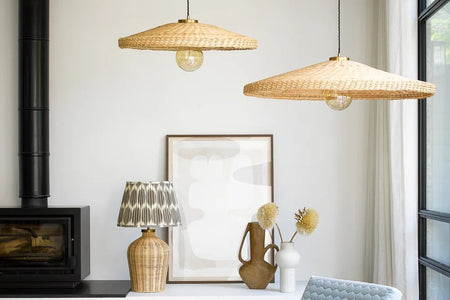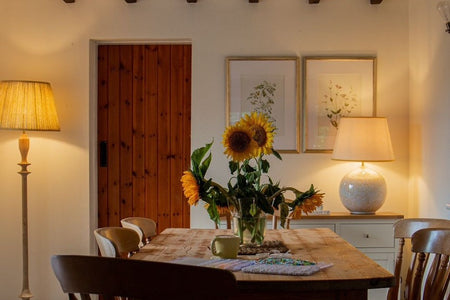
From bold and brash to subtle and slinky – lines and stripes have a trick or two for every room. Let’s see what they can get up to…
What was the very first mark made by a human? Quite possibly a line scratched on a cave wall… Yes, lines and stripes in interiors have a very long, fascinating, and varied history. Lines of all kinds permeate our homes and buildings so thoroughly that much of the time we hardly give them a second glance. Yet they’re the most important tool in your interior design toolkit, essential for planning, layout, and decoration.
So join us for a journey through their history to the present day, with some of our favorite interiors – and of course, Pooky lampshades and lighting that make the most of lines and stripes in all their forms: straight, wonky, curved, horizontal, vertical, even blurred at the edges.
Lining up through the ages

Image: creative commons
As with circles and geometrics, the use of lines takes us back to ancient civilisations; linear patterns were widely used in Egypt, Greece and Rome, as architectural friezes on buildings, on textiles and pottery, to create visual interest and rhythm.
By the Middle Ages in Europe, however, stripes had fallen out of favour as they were associated with outsiders and rulebreakers:prisoners, jesters, those beyond the social order. Decorating your home with stripes was at best risky, at worst a shocking faux pas.
Things began to look up for lines and stripes during the Renaissance and Baroque eras but only up to a point, being relegated to second place behind or between ornate motifs such as damasks, florals and scrollwork. Similarly, stripes began to appear in wood paneling and on textiles but in an understated way.

All that changed dramatically in the 18th century. By then, lines and stripes were ascendant in France and England. Associated with elegance and order, they became central to Rococo and Neoclassical styles—appearing on upholstery, wallpaper, and textiles. Marie-Antoinette adored striped fabrics like toiles and ticking in her private apartments, making them the height of fashion and ushering in a shift toward informal luxury that survived the House of Bourbon’s downfall.

By the nineteenth century, mechanised printing made striped wallpapers more accessible and affordable. Victorian families loved to use stripes on walls and textiles in their homes, in particular using vertical stripes to make ceilings appear higher – and grander. An early reflection, perhaps, of the century’s rising social aspirations and upward mobility, so often satirised by Charles Dickens. What are the chances that Mr and Mrs Veneering, ‘…bran-new people in a bran-new house in a bran-new quarter of London’ (Our Mutual Friend), opted for vertically striped wallpaper?
On the other hand, the widespread use of stripes in functional textiles such as mattress ticking and shop awnings, emphasised the line’s humble, utilitarian appeal.

The Art Deco movement of the 1920s and ‘30s celebrated clean lines and bold geometric stripes. Lines and stripes meant progress and glamour—no looking back now…And by the mid-century, architects and designers such as Le Corbusier and Frank Lloyd Wright made lines, notably horizontal and minimalist, central to their work, using linear elements architecturally and decoratively. Post-modern designers upended this approach and stripes reappeared in the 1970s and ‘80s in more playful and exaggerated forms; Italy’s Memphis Group, in particular, went full-on maximalist with stripes in dazzlingly bright, contrasting colours.
Using lines in your home interior design

Lines and stripes are now pretty much universal. You’ll find them in pared-down minimalist settings, Scandinavian and Japandi-inspired homes, boho, eclectic, ethnic, and maximalist interiors. Whatever your style, lines and stripes always fit in.
They’re hardworking, too. Stripes create clever optical illusions: vertical lines add height, horizontal lines add width, and both suggest movement. Wavy lines amplify that effect! For a cocoon-like vibe in a reading nook or child’s bedroom, try stripes on the ceiling.

One of the most popular ways of using lines and stripes is in textiles and upholstery: bold and wild make a statement, for example on chairs, cushions or rugs; pinstripes and ticking stripes provide a tailored look for bedding and curtains. Combine stripes with florals or plaids for a contemporary maximalist look.
Slatted wood panels have been having something of a moment, especially since Michelle Ogundehin championed them in Interior Design Masters. The Scandinavian/Japandi approach uses vertical or horizontal wooden slats on ceilings, room dividers and walls.
And don’t forget the ground beneath your feet. Striped rugs add energy or help define zones. If you’re feeling brave, try painting bold stripes on the floor for a graphic effect – and a guaranteed talking point.

Whichever way you introduce lines or stripes, it’s important to take colour into consideration too: use black and white stripes for a bold, urban, graphic look; earth-toned or muted stripes are soothing and natural—ideal for minimalist spaces, and colour-rich stripes boost a sense of energy, while multi-coloured stripes are fun—children love them!
On the right lines – Pooky shades
Our straight empire shade in verdant tapers is the biggest design in our handpainted range. Its charm lies in those uneven painted lines; each one is unique.

For something softer and rather comforting, it has to be Pooky’s straight empire shade in calendula chalk stripes. It’s a delightful, soft-edged, slightly wonky stripe, printed on cotton and finished with a solid colour tape. The calendula flower is known for its soothing qualities, so we had no hesitation in borrowing from nature.

Browse all our lights and shades – and find your own favourite patterns – here.
See also:
The seven elements of interior design: Pattern
The seven elements of interior design – a guide to understanding and combining them
How to develop an eye for interior design
The Meaning of Pattern: Circles
The Meaning of Pattern: Geometrics
The Meaning of Pattern: Chevrons and herringbone
Image top: Room by Sean Symington - photo credit @charlottecroftsandco






